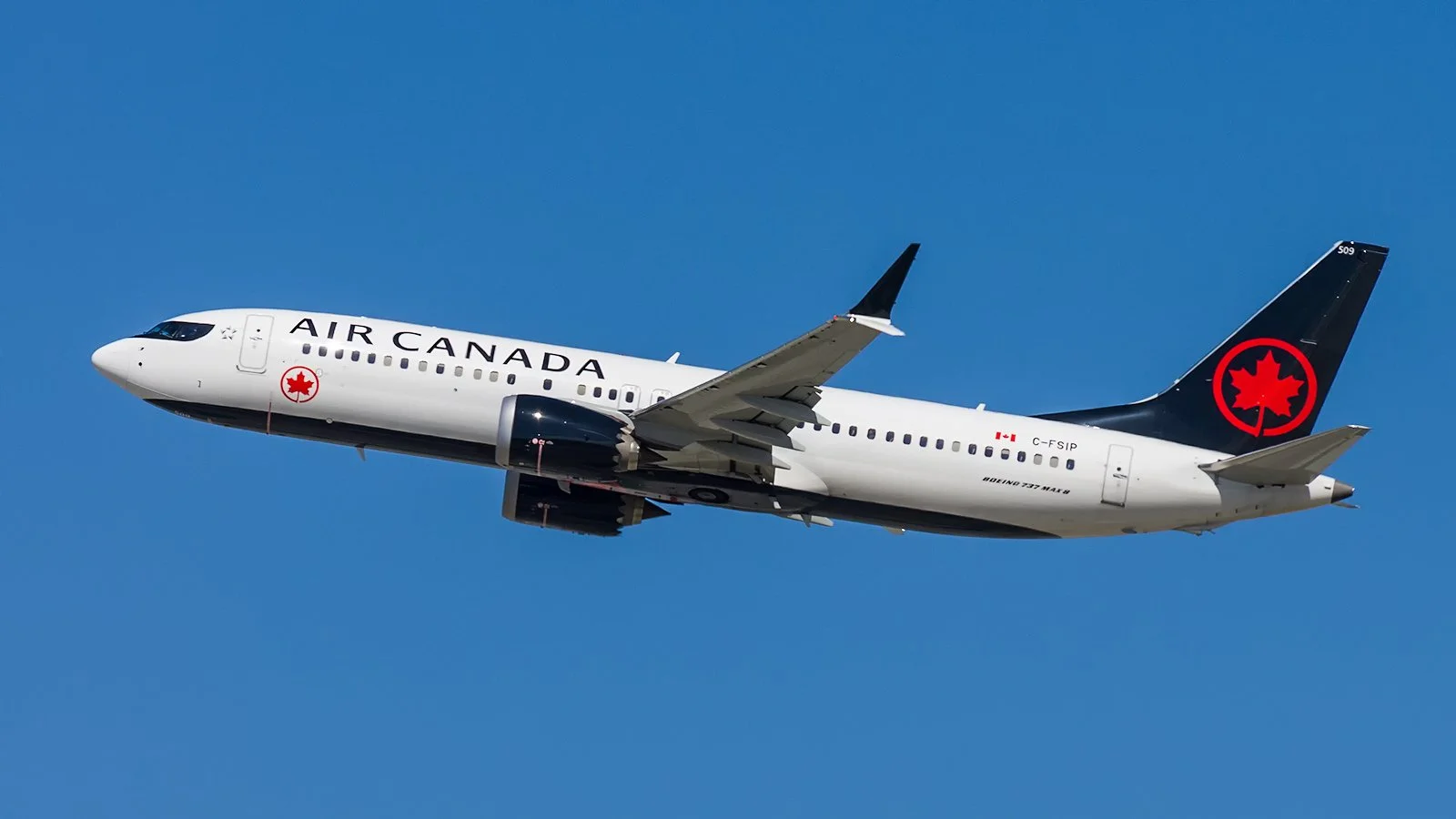5 ways to tell the difference between the 737 MAX and other Boeing 737s
Air Canada Boeing 737 MAX 8 in flight
Image: Flickr/Colin Brown Photography (CC BY 2.0)
You’ve probably heard of the Boeing 737, and by now you are probably well aware of the 737 MAX. With the recent return of the 737 MAX to commercial service after its 20-month long grounding, and dozens of airlines planning on bringing them back online in 2021, one thing that might be on the minds of passengers and general public is how to tell the difference between a 737 MAX and other Boeing 737s? What makes it unique from the others?
To give some background, the Boeing 737 MAX is the 4th generation of the 737, and began its development in the 2010s. The three earlier generations of the 737 are the Original 737 (sometimes affectionately referred to as the “Jurassic” series), which was first developed in the 1960s; the 737 Classic, which began development in the late 1970s; and the 737 Next Generation (NG), which began development in the late 1990s.
Older generations of the aircraft have largely been retired throughout the world, and the MAX generation only began to be delivered in 2017. So if you’ve stepped onto a Boeing 737 in recent years, chances are it was on a Next Generation (also commonly referred to as the 737-600, 737-700, 737-800, and 737-900) series aircraft. However, with several hundred MAXs already built, plus several thousand more on order, the MAX will eventually become the predominant 737 generation taking to the skies.
Now, back to the original point about generations of a product line – similar to how cars and electronics evolve over time with small iterative changes at each generation, so has the Boeing 737. Each generation of the 737 has distinct differences from the other. Since there are very few of the Original and Classic generations of the 737 still flying in the world today, in this article we’ll only make a comparison between the 737 MAX and its immediate predecessor, the 737 NG.
ADVERTISEMENT737 versus similar aircraft
Before we go into the nuances between different generations of the 737, let’s establish the difference between the Boeing 737 and similar aircraft in its class, such as the Airbus A320 (which is its direct competitor), and the Airbus A220 and Embraer E190/E195 families (which cover the lower end of the 100-200 seat aircraft market that these four aircraft families compete in). There are two primary ways to differentiate the 737 family from its competitors:
The 737 has a pointed nose that aligns roughly with the middle of the fuselage. The noses of the A220, A320s, and E190/E195 are all aligned toward the bottom of the fuselage and can generally be regarded as “stubbier” than that of the 737.
The 737 has dorsal fin on its tail, which is a shallow-angled extension added to the front of its tail in order to increase the tail’s surface area without increasing its height. In contrast, the A220 and A320 tails terminate directly into the fuselage. It is worth noting that the Embraer E190/E195 also has a dorsal fin added to its tail, however, the design of the E190/E195’s nose should be enough to differentiate it from a Boeing 737.
Notice how the Boeing 737’s nose is positioned higher up the fuselage (almost aligned with the center) and how there is an added dorsal fin on the tail. Similar aircraft in its class (the Embraer 195, Airbus A220, and Airbus A320) all have their noses positioned toward the bottom of the fuselage and, with the exception of the E195, do not have dorsal fins on their tails.
Images:
Upper Left - Wikimedia Commons/Bene Riobó (CC BY-SA 3.0), cropped and annotated from the original.
Middle Left - Flickr/Anna Zvereva (CC BY-SA 2.0), cropped and annotated from the original.
Lower Left - Flickr/Markus Eigenheer (CC BY-SA 2.0), cropped and annotated from the original.
Right - Flickr/Colin Brown Photography (CC BY 2.0), cropped and annotated from the original.
1) Tail Cone Design
Now that we have established how to identify a 737 from other aircraft, let’s take a look at the first major way to tell the difference between a 737 MAX and older 737 generations. Take look at the back of the aircraft and the shape of its tail cone. The tail cone of the MAX differs greatly from its predecessors.
In the photo comparison below, notice how the tail cone of a MAX is more pointed and extends out further than the shorter and blunter tail cone of the 737 NG.
Top: 737 NG - Notice how the tail cone is shorter and more blunt.
Bottom: 737 MAX - Notice how the tail cone is pointed and extends farther behind the tail and horizontal stabilizer than on the 737 NG.
Images:
Top - Flickr/Alec Wilson (CC BY-SA 2.0), cropped and annotated from original.
Bottom - Flickr/Colin Brown Photography (CC BY 2.0), cropped and annotated from original.
2) Winglet Design
Another major difference between the 737 MAX and other 737s is the design of the winglets at the end of each wing. To begin, only two generations of the 737 have winglets – a majority of NGs have them, and all MAXs have them.
The 3rd generation 737 NG has two variations of winglets – the blended winglet (projecting above the wing), and the Split Scimitar winglets (projecting both above and below the wing). The newer 4th generation 737 MAX generation only uses a split winglet design.
But since the 737 NG and the 737 MAX both have split winglets, is there a way to further differentiate between the two? The answer is yes. Though very similar at first glance, there are distinct design differences between the split winglets of the NG and MAX:
On the NG, the top and bottom edges of the split winglets are sloped and taper to a sharp point at the back. Additionally, the projection angle of the winglets upward and downward off the wing are not as extreme as those of the MAX.
On the MAX, the top and bottom edges are flat, and rather square and boxy, and the projection angle off the wing is at a much sharper angle.
Left: 737 NG (Blended Winglet) - Notice the lack of winglet below the wing.
Middle: 737 NG (Split Scimitar Winglet) - Notice how the upper and lower edges of the winglet are sloped and taper to a point at the rear.
Right: 737 MAX - All 737 MAXs have split winglets. Notice how the upper and lower edges of the winglets remain flat and straight.
Images:
Left - Flickr/Bill Abbott (CC BY-SA 2.0), cropped and annotated from original.
Middle - Wikimedia Commons/Mnts (CC BY-SA 4.0), cropped and annotated from original.
Right - Flickr/Aka The Beav (CC BY 2.0) cropped and annotated from original.
Left: 737 NG (Blended Winglet) - Notice the lack of winglet below the wing.
Middle: 737 NG (Split Scimitar Winglet) - Notice how the upper and lower edges of the winglet are sloped and taper to a point at the rear.
Right: 737 MAX - All 737 MAXs have split winglets. Notice how the upper and lower edges of the winglets remain flat and straight.
Images: The Window Flyer (© All Rights Reserved)
Left: Boeing 737 NG - Notice the slightly shallower angle between the upper and lower winglets.
Right: Boeing 737 MAX - Notice the slightly sharper/more acute angle between the upper and lower winglets.
Images:
Left - Flickr/Tomás Del Coro (CC BY-SA 2.0), cropped and annotated from original.
Right - Flickr/Bill Abbott (CC BY-SA 2.0), cropped and annotated from original.
3) Engine Design
Looking at the plane’s engines is another way to tell the 737 MAX apart from other 737 generations.
The 737 MAX sports newer, more fuel efficient engines than its predecessors. These newer engines, CFM International’s LEAP family, have a larger diameter than the engines of older 737s and to accommodate this, the engines also sit higher on the wings. However, for the casual viewer, it can be understandably hard to gauge this difference in engine size and position without seeing a 737 MAX sitting side-by-side with a 737 from an older generation.
Luckily, there are a couple more conspicuous ways to spot a 737 MAX by its engines even if the aircraft is sitting alone:
The unpainted portion at the front of the 737 MAX’s engines (the nose cowls) is wide, and it's wide enough to be identified on its own versus older 737s. Visually, the cowl is almost as wide as its over wing emergency exit door – for reference, the engine nose cowl on older 737s is a much thinner ring, only about as wide as one of its windows.
The trailing edge at the rear of the 737 MAX’s engine nacelles (a nacelle is the housing that contains the engine) have a distinct chevron pattern on it. The chevrons are designed to reduce the jet blast noise that the engine produces and outputs into the environment, including into the cabin of the aircraft, by controlling the way air mixes after passing through the engine.
Top: Boeing 737 MAX - Notice the increased width of the engine nose cowl (magenta circle) and presence of chevrons on the engine nacelle (green circle).
Bottom: Boeing 737 NG - Notice the narrower width of the engine nose cowl (magenta circle) and straight rear edge of the engine nacelle (green circle).
Images:
Top - Flickr/Anna Zvereva (CC BY-SA 2.0), cropped and annotated from original.
Bottom - Wikimedia Commons/Julian Herzog (CC BY 4.0), cropped and annotated from original.
ADVERTISEMENT4) Engine Noise & Sounds
The type of sound that the 737 MAX’s CFM LEAP-1B engines produce is another way to tell it apart from older Boeing 737s. The sound difference is very distinct, particularly on its takeoff roll:
On an older generation 737 NG, the engines produce a loud roar, and if you happen to be sitting in front of the wing, there is the added bonus of a buzzsaw effect.
On a newer generation 737 MAX, the engines are quieter and produce a high pitch whirl that’s audible in all areas of the cabin.
Check out these YouTube videos below to hear the difference:
737 engine sound from in front of the wing
vs.
737 engine sound from behind the wing
vs.
5) Nose Landing Gear
This difference is probably the most subtle at the outset, but you’ll never un-see it once you make note of it.
To provide some historical context, in the 1960s, when the original generation of the 737 was first designed, air travel by jet engine aircraft was still in its infancy. Therefore, a lot of the smaller, regional airports that the original 737 (-100 and -200 series) was intended to serve were lesser equipped with jetways (officially called passenger boarding bridges, or PBBs) and airport ground support equipment (GSE), such as baggage loaders, that you see at most airports today. To accommodate the more primitive nature of airports during this time, the original generation of the 737 was designed to sit low to the ground. Passengers could board and deplane the original 737 with its built-in air stairs and luggage could be hand-loaded from the ground without special equipment.
As the 737 evolved in the late 1970s to the Classic generation (-300, -400, and -500 series) and again in the late 1990s to the NG generation (-600, -700, -800, and -900 series), it received larger engines, which required Boeing to raise the 737 fuselage by several inches versus the original to ensure the engines had enough clearance off the ground
Moving forward to the 2010s, when the 737 evolved into the current MAX generation (-7, -8, -9, -10 series) the engines got upsized again, necessitating a further raising of the fuselage off the ground. As a result, the 737 MAX has a noticeably longer nose landing gear than the 737 NG generation before it. This difference can be easily picked up on by looking where the bottom edge of the nose landing gear door sits relative to the top of the tires.
On the older 737 NG, the bottom edge of those doors sits just above the tire line. In contrast, on the newer 737 MAX, there is a noticeable gap between the top of the tires and the bottom of the landing gear doors – roughly equal to the width of the landing gear door itself.
Left: Boeing 737 MAX - Because the MAX sits higher off the ground, notice how there is a larger gap between the landing gear door and tires than on the 737 NG.
Right: Boeing 737 NG - Notice how the bottom of the landing gear door sits at almost the same level as the tires.
Images:
Left - Flickr/Dylan Agbagni (CC0/Public Domain)
Right - Flickr/Bill Abbott (CC BY-SA 2.0), cropped and annotated from original.
Conclusion
To recap, the 737 MAX is the 4th and newest generation of the Boeing 737 aircraft. The main ways to tell the difference between it and other 737s are both visual and auditory. From a visual standpoint, the 737 MAX has a different tail cone design, winglet design, engine design, and landing gear design from older generations of the 737. From an auditory standpoint, the 737 MAX’s LEAP-1B engines sound distinctly different than any other 737, with its quieter roar and higher pitch whirl.
In terms of your own flight, airlines will typically be very clear about the type of aircraft your flight is scheduled to be operated on when booking a ticket on their website. This information can often be found by expanding the flight details dialog on the flight selection page. However, since reservations are often made well in advance of your flight, it may be possible that the airline switches up aircraft on the day of your flight based on fleet availability. Aircraft switching is actually quite common up to a couple hours from departure, but is often invisible since airlines are switching planes with an identical type (such as a 737-800 for another 737-800). However, due to the commonality between the 737 NG (-600, -700, -800, -900, series) and the 737 MAX (-7, -8, -9, -10 series) (almost identical seat counts and capabilities), you might book your flight on one generation, and get placed on an aircraft of the other generation on your travel day. It remains to be seen how airlines might handle potential swaps between the NG and MAX generations over the next few months, given that there is still some amount of nervousness amongst the traveling public about flying on a MAX as it returns to service. But many airlines are offering complimentary flight changes for those who may be uncomfortable flying on a MAX, so be sure to check on your airline’s policies regarding this.
At The Window Flyer, we have faith in the MAX, but just in case you’re still anxious about stepping on one, we hope this article has provided you with the resources to be able to identify which model of the 737 you are flying on.
ADVERTISEMENTRelated Content














